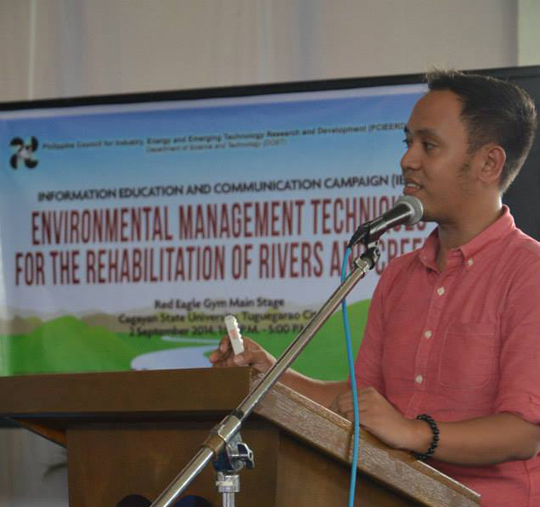As part of PCIEERD’s initiative to disseminate Science and Technology information and educate the public on how they can make S&T work in their everyday activities, PCIEERD conducts Information Education and Communication (IEC) campaigns on specific science topics. These are usually technologies that have undergone the Council’s technology assessment (TA).
During the celebration of the DOST North Luzon Cluster Science and Technology Fair, PCIEERD conducted the “IEC Campaign on Environmental Management Techniques for the Rehabilitation of Rivers and Creeks”. It was held last September 2, 2014 at the Cagayan State University, Tuguegarao.

Photo shows the PCIEERD team (Ms. Arlyn Joy Amata, Ms. Edgilyn Alcasid, Ms. Maria Elena Talingdan and Mr. Lanquin Seyer), and Engr. Jonathan Nuestro from DOST II, together with the forum speakers
One hundred and fifty participants took part in the event where two PCIEERD funded research projects were presented. It was attended by teachers and undergraduate students pursuing studies in Environmental Science, Electronics and Communications Engineering, Chemical Engineering, and Agricultural Engineering. Local Government Unit personnel participated in the IEC as well.
The first topic presented was entitled “Dissolved Oxygen (DO) for Management Strategies of the Pasig River System” and was discussed by Dr. Eligia D. Clemente, Assistant Professor from the University of the Philippines Diliman.
In her presentation, Dr. Clemente compared the Pasig River way back in 1950’s and today. Pollution caused by human and industrial activities degraded the condition of the river through the years. She then illustrated how their project gathered data about the current condition of Pasig River water and its sediment quality. Through the data collected, their study compared the prevailing conditions of the river in terms of household waste generators and effluent loadings with baseline conditions. In particular, their study came-up with a Dissolved Oxygen Modelling for management strategies of the Pasig River system which can help to address and see the effect of pollution loadings in the estero. Such model can help generate data on possible estero remediation techniques as well.

Dr. Eligia Clemente delivering her discussion about Dissolved Oxygen for the Management Strategies of the Pasig River System
Meanwhile, Engr. Bryan Clark B. Hernandez, University Research Associate from the University of the Philippines Diliman, presented the second project entitled “Hydraulic and Hydrologic Characterization for Remediation Technologies”.
The research group was able to develop a model for the hydraulic and hydrologic characterization in the selection of effective water quantity and quality management strategies. Such can serve as tools to assess the dynamics of water movement quantitatively. Also, the model developed can serve as a source to determine the impact and results of interventions for management of creeks and rivers.

Engr. Bryan Clark B. Hernandez presenting the second project for the IEC
In his opening remarks for the IEC, Engr. Sancho A. Mabborang, Assistant Regional Director for Field Operation Services in DOST Region II, said the results of the projects about the rehabilitation of the Pasig River can be used as references to improve the state of the Cagayan River and educate the students on how they can partake in its restoration as well. (Edgilyn R. Alcasid)




